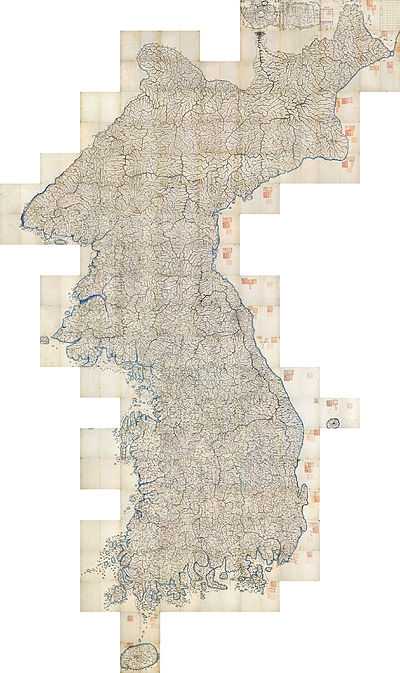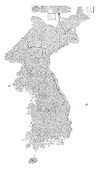Kim Jeong-ho
| Kim Jeong-ho | |
| Hangul | 김정호 |
|---|---|
| Hanja | 金正浩 |
| Revised Romanization | Gim Jeong-ho |
| McCune–Reischauer | Kim Chŏng-ho |
| Pen name | |
| Hangul | 고산자 |
| Hanja | 古山子 |
| Revised Romanization | Gosanja |
| McCune–Reischauer | Kosanja |
| Courtesy name | |
| Hangul | 백원 also 백온 |
| Hanja | 伯元 also 伯溫 |
| Revised Romanization | Baegwon also Baegon |
| McCune–Reischauer | Paegwŏn also Paegon |
| Korean pronunciation: [kimdʑʌŋho, koːsandʑa, pɛɡwʌn/pɛɡon] | |

Kim Jeong-ho (pen name Gosanja; ‘the guy of old mountain’ 1804-1866?) was a Korean geographer and cartographer. He was born in Hwanghaedo. It is believed that he walked the entire length and breadth of the Korean peninsula, through mountain and valley, in order to research and compile his magnum opus, the Daedongyeojido, (대동여지도, 大東輿地圖) a map of Korea that was published in 1861, from which was subsequently made a single-sheet version, the Daedongyeojijeondo (대동여지전도 大東與地全圖).
The events surrounding Kim's death are obscure. Following the publication of a later version of the Daedong Yeojido in 1866 Kim is not heard from again. The document from the Governor-General of Korea asserts that the Korean regent Daewongun, upon viewing the later version of Kim's great map, became incensed by its inclusion of details of a sensitive nature critical to national defense. According to the document, the Daewongun was arrested and jailed and the maps had been destroyed.[1]
However, this is not true, as the original wood printing block of Daedong Yeojido still can be found in the Soongsil University and also in the Korea University. Furthermore, the people who helped to develop the map such as Choe Han-gi and Shin Hun was not convicted at all. The Korean historical community believes that the document was a fabrication by the General-Government.[2]
The asteroid 95016 Kimjeongho is named in his honour.
Gallery
-

Daedong Yeoji Jeondo
-

Daedong Yeoji Jeondo, another version.
-

Yeoji Jeondo.
-

Suseon jeondo.
See also
- List of Korea-related topics
- Geography of South Korea
- Geography of North Korea
- Kim's 1861 map held at the American Geographical Society Library, University of Wisconsin Milwaukee
References
- ↑ General-Government of Korea, 〈조선어 독본 5〉, 1934, page 23 ~ 24
- ↑ Lee Sang-tae, 〈고산자 김정호의 생애와 사상〉, 1991, page 141
Further reading
- Kane, Daniel C. (2003), “Martyr to a Map: the Inscrutable Father of Korean Cartography”. Mercator’s World, Vol. 8, No. 1 (January/February 2003).
- Cope, Angela (2009), "Korean National Treasure Identified in AGS Library." UWM Libraries Newsletter, Fall 2009, No. 56.
- Ledyard, Gari (1994) "Cartography in Korea." The History of Cartography, Vol. 2, Book 2, (Ledyard includes a good biography of Kim with description of his contribution to cartography in Korea and Asia).